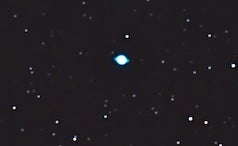
The Saturn Nebula (NGC 7009) was one of the first oddball planetary nebulae known. As the name suggests, this dying star resembles the planet — albeit crudely. It doesn’t actually have rings but sports highly elongated equatorial projections, called ansae. William Herschel observed it from England in 1782 but William Parsons, Earl of Rosse, named it in the 1840s, after his 72-inch telescope revealed the odd structures.
Today, a good 8-inch telescope will give you a nice view, revealing the shape it took larger speculum mirrors to see nearly 180 years ago. At 8th magnitude, this object is bright enough for scopes over 6 inches to show a brilliant green color. The nebulae around dying solar-type stars typically emit this fluorescent green glow as oxygen gas in the envelope is excited by the central stellar remnant.
What causes the odd shape? Multiple eruptions from the star — now a white dwarf — sent new gas to interact with previous outflows. Planetary nebulae are diverse, as the dynamic interaction of gases as the star loses mass often creates unique structures. Most of that detail is too fine to be seen in typical amateur telescopes.
Look 1° west of Nu (ν) Aquarii to find this wonderful object. The magnitude 11.5 central star is visible in modest instruments, not a challenge compared to the Ring Nebula (M57). The brightest portion of the nebula is 24″ by 17″ and distinctly oval in shape. The outer shell nearly doubles its size. Like many planetaries, determining its distance is challenging. Estimates place NGC 7009 anywhere from 2,000 to 4,000 light-years away. That means the gas envelope is between 0.2 and 0.4 light-year across.









